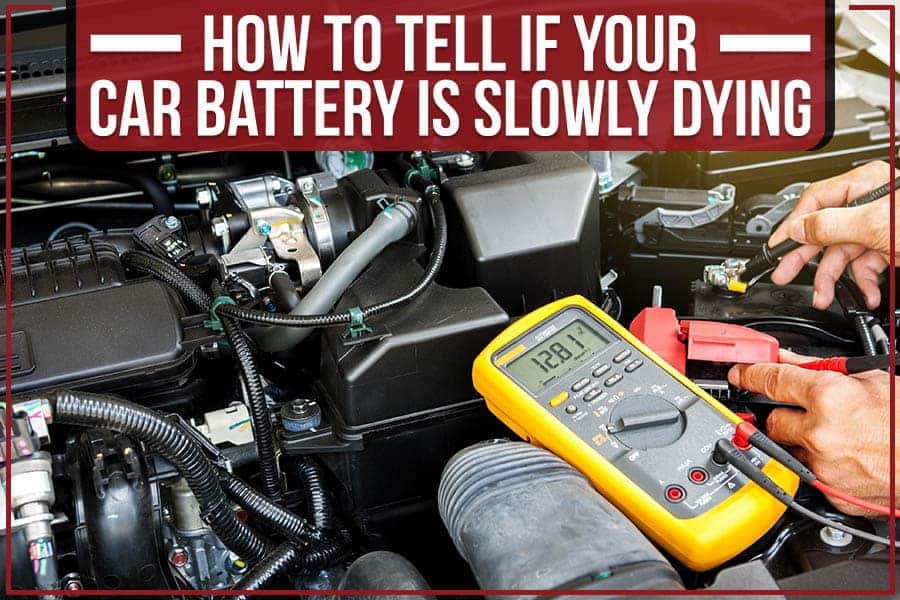How to Tell If Your Battery is Dying
To determine if your battery is dying, watch for slow cranking and dimming headlights. Ignoring these signs could lead to car breakdowns, inconveniences, and costly repairs.
As a responsible car owner, being proactive in recognizing battery issues is crucial to ensuring the longevity of your vehicle. We will explore common symptoms of a failing battery, provide tips for maintenance, and discuss the importance of addressing battery problems promptly.
By being aware of the warning signs and taking the necessary precautions, you can avoid unexpected battery failures and ensure smooth and reliable operation of your vehicle. Let’s dive into the details to help you stay informed and proactive in caring for your car’s battery.
Signs Of A Dying Battery
Is your car battery on its last legs? Look out for warning signs like dim headlights, slow engine cranking, and a struggling electrical system. Don’t get caught off guard – know how to tell if your battery is dying.
Slow Engine Crank
One indicator that your car’s battery may be dying is a slow engine crank. When you start your vehicle, if you notice that the engine hesitates to turn over or struggles to start, this could be a sign that the battery is losing its charge.
Dim Headlights
Another common indication of a dying battery is dim headlights. When you turn on your car‘s headlights and they appear noticeably dimmer than usual, it could mean that the battery is struggling to provide enough power to the electrical components of the vehicle.
:max_bytes(150000):strip_icc()/why-car-battery-keeps-dying-4125506-a2fbb3e180be4fcfb8bdf42bd8ae1bb6.png)
Credit: www.lifewire.com
Battery Warning Signs
Discovering possible battery warning signs is crucial to prevent unexpected breakdowns.
Dashboard Warning Light
Your vehicle’s dashboard warning light illuminating unexpectedly can indicate a battery issue.
Electrical Issues
Experiencing unexplained electrical problems like flickering lights signify potential battery troubles.
Testing Your Battery
To determine if your battery is dying, you can test it by using a multimeter or getting a professional check. Look for signs like slow engine crank, dimming lights, or a dashboard warning. Regular battery checks can help avoid unexpected breakdowns and save you from costly repairs.
Testing Your Battery Your vehicle’s battery plays a crucial role in its overall performance, so it’s essential to regularly check for any signs of a dying battery. Testing your battery is a simple process that can save you from unexpected breakdowns.Voltage Check
One way to test your battery is by conducting a voltage check using a multimeter. Connect the positive and negative terminals, ensuring a reading between 12.4 to 12.6 volts indicates a healthy battery.Load Test
Another method to assess your battery’s health is by performing a load test. This test assesses the battery’s ability to deliver power under stress. If it fails, consider a replacement. By testing your battery using these methods, you can identify issues early and ensure your vehicle stays reliable on the road.
Credit: www.tireoutlet.com
Preventing Battery Issues
Regular maintenance of your car battery is crucial in ensuring its longevity and performance. By following a few simple steps and best practices, you can prevent battery issues and extend the life of your vehicle’s battery.
Regular Maintenance
Regular maintenance of your car battery includes ensuring that the connections are clean and tight, and the terminals are free from corrosion. It’s also essential to check the electrolyte levels and top up with distilled water if necessary. Additionally, testing the battery’s voltage and inspecting for any physical damage can help identify potential issues early on.
Avoiding Short Trips
Avoiding short trips is another key factor in preventing battery issues. Short trips do not allow the alternator enough time to recharge the battery fully, leading to gradual depletion. Whenever possible, try to combine errands into one trip to minimize the number of short journeys and give the battery sufficient time to charge.
What To Do If Your Battery Is Dying
What to Do if Your Battery is Dying
If you suspect that your battery is dying, there are a few steps you can take to address the issue. Whether you choose to jump-start the battery or replace it entirely, it’s essential to know the right course of action to get your vehicle up and running again. In this section, we’ll discuss two options to consider: jump-starting the battery and replacing the battery.
Jump-start The Battery
If you’re dealing with a dying battery, jump-starting it might be a quick fix to get your vehicle running again.
To jump-start the battery, you’ll need jumper cables and another vehicle with a working battery. Follow these steps:
- Position the vehicles so their batteries are facing each other, but not touching.
- Ensure both vehicles are turned off and the emergency brakes are engaged.
- Connect one end of the positive jumper cable (usually red) to the positive terminal of the dead battery and the other end to the positive terminal of the charged battery.
- Connect one end of the negative jumper cable (usually black) to the negative terminal of the charged battery.
- Attach the other end of the negative cable to an unpainted metal surface on the vehicle with the dead battery, such as a bolt or bracket.
- Start the working vehicle and let it run for a few minutes to charge the dead battery.
- Try starting the vehicle with the dead battery. If it starts, let it run for a while to recharge the battery.
- Once the vehicle is running, carefully disconnect the jumper cables in the reverse order that you connected them.
Note: Jump-starting a battery is a temporary solution, and it’s advisable to have your battery tested or replaced to prevent further issues.
Replace The Battery
If your battery continues to show signs of dying, it may be time for a replacement.
Here are the steps to replace your battery:
- Ensure the vehicle is turned off.
- Open the hood and locate the battery.
- Disconnect the negative terminal first by loosening the nut and carefully removing the cable from the terminal.
- Repeat the same process for the positive terminal.
- Remove any brackets or fasteners holding the battery in place.
- Lift out the old battery and place the new one in the same position.
- Reattach the brackets or fasteners to secure the new battery.
- Connect the positive terminal first by placing the cable onto the terminal and tightening the nut.
- Repeat the same process for the negative terminal.
Remember: It’s crucial to properly dispose of the old battery at a local recycling center or an authorized battery retailer. They can ensure its safe disposal and environmental sustainability.

Credit: www.jackhananiabuickgmc.com
Frequently Asked Questions Of How To Tell If Your Battery Is Dying
How Do I Know When My Car Needs A New Battery?
You’ll need a new car battery if you experience slow engine crank, dim lights, or frequent jump-starts.
How Can I Tell When My Car Battery Is Dying?
You can tell when your car battery is dying if it takes longer to start the engine or if you notice dim headlights.
How Do I Know If My Car Battery Is Weak?
You can tell your car battery is weak when it takes longer to start the engine, the headlights are dim, or accessories don’t work properly. A weak battery may also trigger the check engine light or dashboard warnings. Regularly check and maintain your battery to prevent issues.
How Can I Test If My Battery Is Bad?
To test if your battery is bad, use a voltmeter to measure its voltage. A good battery should have a voltage of around 12. 6 volts. If the reading is significantly lower, it may indicate a bad battery. Alternatively, have a professional mechanic test it for you.
How Can I Tell If My Battery Is Dying?
A dying battery can be indicated by dim headlights, slow engine cranking, and a weak start.
What Are The Signs Of A Dying Car Battery?
Some common signs include a clicking noise when starting, engine sputtering, and frequent need for jump-starts.
How Long Does A Car Battery Last Before Dying?
The lifespan can vary, but on average, a car battery may last around 3 to 5 years before it starts dying.
Conclusion
As you go about your day, keep an eye out for the signs of a dying battery. Addressing these issues promptly can save you from being stranded with a car that won’t start. By recognizing the symptoms and taking preventive measures, you can prolong the life of your car battery and avoid unexpected breakdowns.
Remember, maintenance is key in keeping your vehicle running smoothly.

